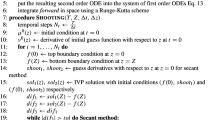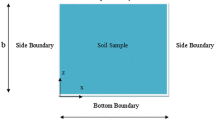Abstract
The problem of modeling water flow in the root zone with plant root absorption is of crucial importance in many environmental and agricultural issues, and is still of interest in the applied mathematics community. In this work we propose a formal justification and a theoretical background of a recently introduced numerical approach, based on the shooting method, for integrating the unsaturated flow equation with a sink term accounting for the root water uptake model. Moreover, we provide various numerical simulations for this method, comparing the results with the numerical solutions obtained by MATLAB pdepe .
Access this chapter
Tax calculation will be finalised at checkout
Purchases are for personal use only
Similar content being viewed by others
References
Maggi, S.: Estimating water retention characteristic parameters using differential evolution. Comput. Geotech. 86, 163–172 (2017). https://doi.org/10.1016/j.compgeo.2016.12.025
Friedman, S.P., Communar, G., Gamliel, A.: DIDAS - user-friendly software package for assisting drip irrigation design and scheduling. Comput. Electron. Agricult. 120, 36–52 (2016). https://doi.org/10.1016/j.compag.2015.11.007
Brunetti, G., Šimůnek, J., Bautista, E.: A hybrid finite volume-finite element model for the numerical analysis of furrow irrigation and fertigation. Comput. Electron. Agricult. 150, 312–327 (2018). https://doi.org/10.1016/j.compag.2018.05.013
Arbat, G., Puig-Bargués, J., Duran-Ros, M., Barragán, J., de Cartagena, F.R.: Drip-Irriwater: computer software to simulate soil wetting patterns under surface drip irrigation. Comput. Electron. Agricult. 98, 183–192 (2013). https://doi.org/10.1016/j.compag.2013.08.009
Berardi, M., Difonzo, F., Notarnicola, F., Vurro, M.: A transversal method of lines for the numerical modeling of vertical infiltration into the vadose zone. Appl. Numer. Math. 135, 264–275 (2019). https://doi.org/10.1016/j.apnum.2018.08.013
Berardi, M., Difonzo, F.V.: Strong solutions for Richards’ equation with Cauchy conditions and constant pressure gradient. Environ. Fluid Mech. 20(1), 165–174 (2019). https://doi.org/10.1007/s10652-019-09705-w
Casulli, V.: A coupled surface-subsurface model for hydrostatic flows under saturated and variably saturated conditions. Int. J. Numer. Meth. Fluids 85(8), 449–464 (2017). https://doi.org/10.1002/fld.4389
Nordbotten, J.M., Boon, W.M., Fumagalli, A., Keilegavlen, E.: Unified approach to discretization of flow in fractured porous media. Comput. Geosci. 23(2), 225–237 (2018). https://doi.org/10.1007/s10596-018-9778-9
Berre, I., et al.: Verification benchmarks for single-phase flow in three-dimensional fractured porous media. Adv. Water Resour. 147, 103759 (2021). https://doi.org/10.1016/j.advwatres.2020.103759
Berardi, M.: Rosenbrock-type methods applied to discontinuous differential systems. Math. Comput. Simul. 95, 229–243 (2014). https://doi.org/10.1016/j.matcom.2013.05.006
Lopez, L., Maset, S.: Time-transformations for the event location in discontinuous ODEs. Math. Comp. 87(3), 2321–2341 (2018). https://doi.org/10.1090/mcom/3305
Del Buono, N., Elia, C., Lopez, L.: On the equivalence between the sigmoidal approach and Utkin’s approach for piecewise-linear models of gene regulatory. SIAM J. Appl. Dyn. Syst. 13(3), 1270–1292 (2014). https://doi.org/10.1137/130950483
Berardi, M., Difonzo, F., Vurro, M., Lopez, L.: The 1D Richards’ equation in two layered soils: a Filippov approach to treat discontinuities. Adv. Water Resour. 115, 264–272 (2018). https://doi.org/10.1016/j.advwatres.2017.09.027
Berardi, M., Difonzo, F., Lopez, L.: A mixed MoL-TMoL for the numerical solution of the 2D Richards’ equation in layered soils. Comput. Math. Appl. 79(7), 1990–2001 (2019). https://doi.org/10.1016/j.camwa.2019.07.026
Difonzo, F.V., Masciopinto, C., Vurro, M., Berardi, M.: Shooting the numerical solution of moisture flow equation with root water uptake models: a Python tool. Water Resour. Manage. 35(8), 2553–2567 (2021). https://doi.org/10.1007/s11269-021-02850-2
Camporese, M., Daly, E., Paniconi, C.: Catchment-scale Richards equation-based modeling of evapotranspiration via boundary condition switching and root water uptake schemes. Water Resour. Res. 51(7), 5756–5771 (2015). https://doi.org/10.1002/2015WR017139
Manoli, G., Bonetti, S., Scudiero, E., Morari, F., Putti, M., Teatini, P.: Modeling soil-plant dynamics: assessing simulation accuracy by comparison with spatially distributed crop yield measurements. Vadose Zone J. 14(2) (2015), vzj2015-05. https://doi.org/10.2136/vzj2015.05.0069
Roose, T., Fowler, A.: A model for water uptake by plant roots. J. Theor. Biol. 228(2), 155–171 (2004). https://doi.org/10.1016/j.jtbi.2003.12.012
Couvreur, V., Vanderborght, J., Javaux, M.: A simple three-dimensional macroscopic root water uptake model based on the hydraulic architecture approach. Hydrol. Earth Syst. Sci. 16(8), 2957–2971 (2012). https://doi.org/10.5194/hess-16-2957-2012
Albrieu, J.L.B., Reginato, J.C., Tarzia, D.A.: Modeling water uptake by a root system growing in a fixed soil volume. Appl. Math. Model. 39(12), 3434–3447 (2015). https://doi.org/10.1016/j.apm.2014.11.042
Simunek, J., Hopmans, J.W.: Modeling compensated root water and nutrient uptake. Ecol. Model. 220(4), 505–521 (2009). https://doi.org/10.1016/j.ecolmodel.2008.11.004
Broadbridge, P., Daly, E., Goard, J.: Exact solutions of the Richards equation with nonlinear plant-root extraction. Water Resour. Res. 53(11), 9679–9691 (2017). https://doi.org/10.1002/2017WR021097
Mathur, S., Rao, S.: Modeling water uptake by plant roots. J. Irrig. Drain. Eng. 125(3), 159–165 (1999). https://doi.org/10.1061/(ASCE)0733-9437(1999)125:3(159)
D’Abbicco, M., Buono, N.D., Gena, P., Berardi, M., Calamita, G., Lopez, L.: A model for the hepatic glucose metabolism based on hill and step functions. J. Comput. Appl. Math. 292, 746–759 (2016). https://doi.org/10.1016/j.cam.2015.01.036
Feddes, R.A., Kowalik, P., Kolinska-Malinka, K., Zaradny, H.: Simulation of field water uptake by plants using a soil water dependent root extraction function. J. Hydrol. 31(1), 13–26 (1976). https://doi.org/10.1016/0022-1694(76)90017-2
Berardi, M., Girardi, G., D’Abbico, M., Vurro, M.: Optimizing water consumption in Richards’ equation framework with step-wise root water uptake: a simplified model (2021, submitted)
Jarvis, N.: A simple empirical model of root water uptake. J. Hydrol. 107(1), 57–72 (1989). https://doi.org/10.1016/0022-1694(89)90050-4
Babazadeh, H., Tabrizi, M., Homaee, M.: Assessing and modifying macroscopic root water extraction basil (ocimum basilicum) models under simultaneous water and salinity stresses. Soil Sci. Soc. Am. J. 81, 10–19 (2017). https://doi.org/10.2136/sssaj2016.07.0217
Coppola, A., Chaali, N., Dragonetti, G., Lamaddalena, N., Comegna, A.: Root uptake under non-uniform root-zone salinity. Ecohydrology 8(7), 1363–1379 (2015). https://doi.org/10.1002/eco.1594
Bergamaschi, L., Putti, M.: Mixed finite elements and Newton-type linearizations for the solution of Richards’ equation. Int. J. Numer. Meth. Eng. 45, 1025–1046 (1999). https://doi.org/10.1002/(SICI)1097-0207(19990720)45:8<1025::AID-NME615>3.0.CO;2-G
Li, N., Yue, X., Ren, L.: Numerical homogenization of the Richards equation for unsaturated water flow through heterogeneous soils. Water Resour. Res. 52(11), 8500–8525 (2016). https://doi.org/10.1002/2015WR018508
Suk, H., Park, E.: Numerical solution of the Kirchhoff-transformed Richards equation for simulating variably saturated flow in heterogeneous layered porous media. J. Hydrol. 579, 124213 (2019). https://doi.org/10.1016/j.jhydrol.2019.124213
Mathews, J.H., Fink, K.K.: Numerical Methods Using MATLAB, 4th edn. Pearson, New York (2004)
D’Ambrosio, R., Jackiewicz, Z.: Construction and implementation of highly stable two-step continuous methods for stiff differential systems. Math. Comput. Simul. 81(9), 1707–1728 (2011). https://doi.org/10.1016/j.matcom.2011.01.005
Carsel, R.F., Parrish, R.S.: Developing joint probability distributions of soil water retention characteristics. Water Resour. Res. 24(5), 755–769 (1988). https://doi.org/10.1029/WR024i005p00755
Li, K.Y., De Jong, R., Coe, M.T., Ramankutty, N.: Root-water-uptake based upon a new water stress reduction and an asymptotic root distribution function. Earth Interact. 10(14), 1–22 (2006)
Berardi, M., Difonzo, F.: A quadrature-based scheme for numerical solutions to Kirchhoff transformed Richards’ equation (2021, submitted)
Lopez, L., Pellegrino, S.F.: A spectral method with volume penalization for a nonlinear peridynamic model. Int. J. Numer. Meth. Eng. 122(3), 707–725 (2020). https://doi.org/10.1002/nme.6555
Lopez, L., Pellegrino, S.F.: A space-time discretization of a nonlinear peridynamic model on a 2D lamina (2021)
Lopez, L., Pellegrino, S.F., Coclite, G., Maddalena, F., Fanizzi, A.: Numerical methods for the nonlocal wave equation of the peridynamics. Appl. Numer. Math. 155, 119–139 (2018). https://doi.org/10.1016/j.apnum.2018.11007
Carminati, A.: A model of root water uptake coupled with rhizosphere dynamics. Vadose Zone J. 11, vzj2011-0106 (2012). https://doi.org/10.2136/vzj2011.0106
Kroener, E.: How mucilage affects soil hydraulic dynamics. J. Plant Nutr. Soil Sci. 184, 20–24 (2021). https://doi.org/10.1002/jpln.202000545
Wu, X., Zuo, Q., Shi, J., Wang, L., Xue, X., Ben-Gal, A.: Introducing water stress hysteresis to the Feddes empirical macroscopic root water uptake model. Agricult. Water Manage. 240, 106293 (2020). https://doi.org/10.1016/j.agwat.2020.106293
Tubini, N., Gruber, S., Rigon, R.: A method for solving heat transfer with phase change in ice or soil that allows for large time steps while guaranteeing energy conservation. Cryosphere Discuss. 2020, 1–41 (2020). https://doi.org/10.5194/tc-2020-293
Acknowledgments
The first author has been funded by REFIN Project, grant number 812E4967. The second author acknowledges the partial support of the project RIUBSAL (grant number 030_DIR_2020_00178), funded by Regione Puglia through the P.S.R. Puglia 2014/2020 - Misura 16 – Cooperazione - Sottomisura 16.2 call.
Author information
Authors and Affiliations
Corresponding author
Editor information
Editors and Affiliations
Rights and permissions
Copyright information
© 2021 Springer Nature Switzerland AG
About this paper
Cite this paper
Difonzo, F.V., Girardi, G. (2021). On the Shooting Method Applied to Richards’ Equation with a Forcing Term. In: Gervasi, O., et al. Computational Science and Its Applications – ICCSA 2021. ICCSA 2021. Lecture Notes in Computer Science(), vol 12949. Springer, Cham. https://doi.org/10.1007/978-3-030-86653-2_20
Download citation
DOI: https://doi.org/10.1007/978-3-030-86653-2_20
Published:
Publisher Name: Springer, Cham
Print ISBN: 978-3-030-86652-5
Online ISBN: 978-3-030-86653-2
eBook Packages: Computer ScienceComputer Science (R0)




